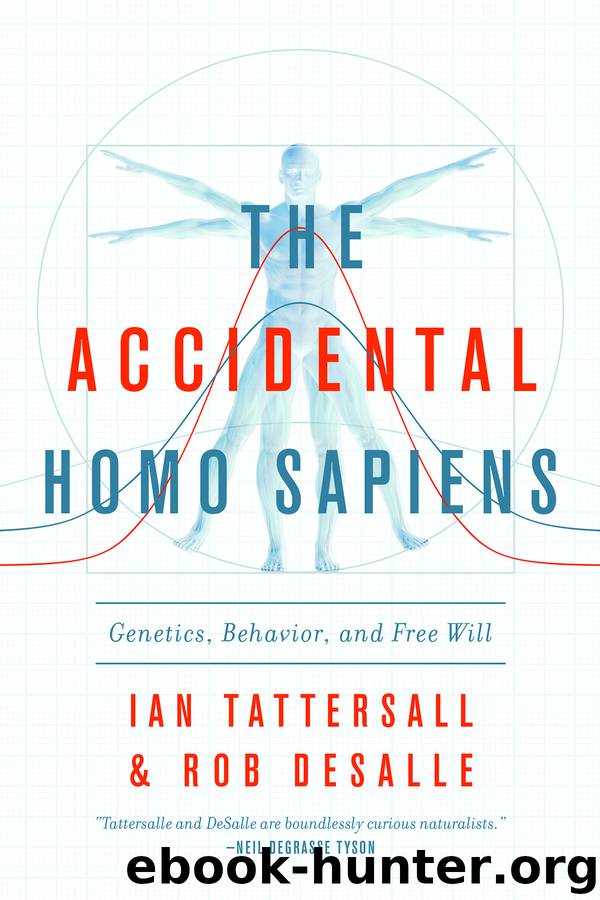The Accidental Homo Sapiens by Ian Tattersall

Author:Ian Tattersall
Language: eng
Format: epub
Publisher: Pegasus Books
Published: 2019-02-06T16:00:00+00:00
Comparison of a reconstructed composite Neanderthal skeleton with a Homo sapiens of similar stature. Note the extensive differences, especially in the cranium and the thoracic and pelvic regions. Photograph by Ken Mowbray.
To judge from the extent of the typical Neanderthal living site, social group sizes were quite small (certainly compared to those of the Cro-Magnons, who seem sometimes to have come together into groupings of several hundred). At one site in Spain, an entire social group of Neanderthals is believed to have been massacred and subsequently butchered, presumably by other Neanderthals, among whom cannibalism appears not to have been an infrequent practice. The unfortunate group consisted of a probably representative twelve individuals: six adults, three adolescents, two juveniles, and an infant. DNA diversity was quite low among them all, but the three adult males were very closely related, while the three adult females came from other DNA lineages, suggesting that the core Neanderthal group was composed of males, while females left at puberty to live with other groups.
The Neanderthals employed flexible economic strategies that varied according to what was available in the local habitat, and they clearly understood and exploited their environments with great subtlety and finesse. Sometimes, small as their groups might have been, they hunted fearsomely large mammal prey such as mammoths and woolly rhinoceroses, using stone-tipped spears. At other times and in other places they went after much smaller game—at one Mediterranean site they apparently specialized in tortoises. And everywhere, they exploited whatever plant resources were available—though the colder it got in those times of notoriously unstable climates, the greater their dependence would necessarily have been on those big grazing mammals.
Shortly before their disappearance, the Neanderthals were joined in their European heartland by modern humans, African in origin, who had begun to trickle into the region by about forty-three thousand years ago. There is evidence from DNA (not entirely uncontested) of some genetic intermixing between the resident hominids and the newcomers, but interaction of this kind would not be unexpected between two young species that had shared a common ancestry not much more than half a million years earlier. What is more important is that such interaction seems not to have materially affected the future biological trajectory of either participant in the process. The Neanderthals went on to become extinct identifiably as the creatures they had been for two hundred millennia; and, the odd “Neanderthal gene” notwithstanding, we are basically the same species today as we were then.
The precise reasons for Neanderthal disappearance have been much debated: Were they assimilated? Exterminated? Outcompeted? Infected with pathogens? Were they already on their way out, and simply vulnerable to a final minor coup de grâce? Anything and everything is possible, and a recent report does appear to document pretty conclusively that the Neanderthals were under particular climatic stress around the time of their disappearance. But, irrespective of the details, there can be little doubt that in a global sense the arrival of Homo sapiens was implicated in the Neanderthal extinction.
Download
This site does not store any files on its server. We only index and link to content provided by other sites. Please contact the content providers to delete copyright contents if any and email us, we'll remove relevant links or contents immediately.
Rewire Your Anxious Brain by Catherine M. Pittman(17611)
Talking to Strangers by Malcolm Gladwell(11935)
The Art of Thinking Clearly by Rolf Dobelli(8886)
Mindhunter: Inside the FBI's Elite Serial Crime Unit by John E. Douglas & Mark Olshaker(7867)
Becoming Supernatural by Dr. Joe Dispenza(7135)
Change Your Questions, Change Your Life by Marilee Adams(6678)
The Road Less Traveled by M. Scott Peck(6664)
Nudge - Improving Decisions about Health, Wealth, and Happiness by Thaler Sunstein(6656)
The Lost Art of Listening by Michael P. Nichols(6501)
Enlightenment Now: The Case for Reason, Science, Humanism, and Progress by Steven Pinker(6428)
Win Bigly by Scott Adams(6338)
Mastermind: How to Think Like Sherlock Holmes by Maria Konnikova(6269)
The Way of Zen by Alan W. Watts(5822)
Daring Greatly by Brene Brown(5674)
Grit by Angela Duckworth(4757)
Big Magic: Creative Living Beyond Fear by Elizabeth Gilbert(4749)
Men In Love by Nancy Friday(4359)
Flow by Mihaly Csikszentmihalyi(4074)
The Four Tendencies by Gretchen Rubin(4039)
